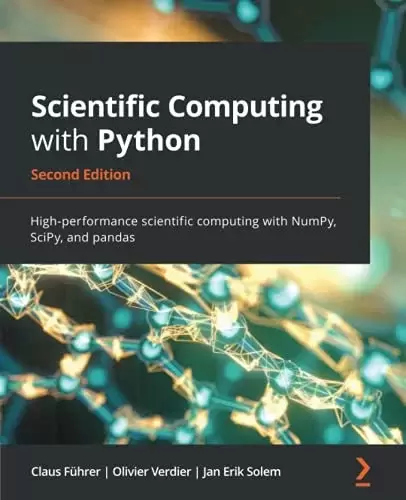
Book Description
Leverage this example-packed, comprehensive guide for all your Python computational needs
Key Features
- Learn the first steps within Python to highly specialized concepts
- Explore examples and code snippets taken from typical programming situations within scientific computing.
- Delve into essential computer science concepts like iterating, object-oriented programming, testing, and MPI presented in strong connection to applications within scientific computing.
Book Description
Python has tremendous potential within the scientific computing domain. This updated edition of Scientific Computing with Python features new chapters on graphical user interfaces, efficient data processing, and parallel computing to help you perform mathematical and scientific computing efficiently using Python.
This book will help you to explore new Python syntax features and create different models using scientific computing principles. The book presents Python alongside mathematical applications and demonstrates how to apply Python concepts in computing with the help of examples involving Python 3.8. You’ll use pandas for basic data analysis to understand the modern needs of scientific computing, and cover data module improvements and built-in features. You’ll also explore numerical computation modules such as NumPy and SciPy, which enable fast access to highly efficient numerical algorithms. By learning to use the plotting module Matplotlib, you will be able to represent your computational results in talks and publications. A special chapter is devoted to SymPy, a tool for bridging symbolic and numerical computations.
By the end of this Python book, you’ll have gained a solid understanding of task automation and how to implement and test mathematical algorithms within the realm of scientific computing.
What you will learn
- Understand the building blocks of computational mathematics, linear algebra, and related Python objects
- Use Matplotlib to create high-quality figures and graphics to draw and visualize results
- Apply object-oriented programming (OOP) to scientific computing in Python
- Discover how to use pandas to enter the world of data processing
- Handle exceptions for writing reliable and usable code
- Cover manual and automatic aspects of testing for scientific programming
- Get to grips with parallel computing to increase computation speed
Who this book is for
This book is for students with a mathematical background, university teachers designing modern courses in programming, data scientists, researchers, developers, and anyone who wants to perform scientific computation in Python.
Table of Contents
- Getting Started
- Variables and Basic Types
- Container Types
- Linear Algebra – Arrays
- Advanced Array Concepts
- Plotting
- Functions
- Classes
- Iterating
- Series and Dataframes – Working With Pandas
- Communication by a Graphical User Interface
- Error and Exception Handling
- Namespaces, Scopes, and Modules
- Input and Output
- Testing
- Symbolic Computations – SymPy
- Interacting with the Operating System
- Python for Parallel Computing
- Comprehensive Examples
中文:
书名:Scientific Computing with Python: High-performance scientific computing with NumPy, SciPy, and pandas, 2nd Edition
充分利用这份包含大量示例的全面指南,满足您的所有Python计算需求
Key Features
- 学习在Python中学习高度专业化概念的第一步
- 探索取自科学计算中典型编程情况的示例和代码片段。
- 深入研究基本的计算机科学概念,如迭代、面向对象的编程、测试和MPI,这些概念与科学计算中的应用程序紧密相关。
Book Description
在科学计算领域,Python具有巨大的潜力。这本更新版的《科学计算与Python》新增了关于图形用户界面、高效数据处理和并行计算的章节,以帮助您使用Python高效地执行数学和科学计算。
本书将帮助您探索新的Python语法特性,并使用科学计算原理创建不同的模型。本书介绍了与数学应用程序一起使用的Python,并通过涉及到Python3.8的例子演示了如何在计算中应用Python概念。您将使用PANAS进行基本数据分析,以了解科学计算的现代需求,并介绍数据模块改进和内置功能。您还将探索NumPy和SciPy等数值计算模块,它们可以快速访问高效的数值算法。通过学习使用绘图模块Matplotlib,您将能够在演讲和出版物中展示您的计算结果。有一章专门介绍了SymPy,这是一种连接符号计算和数值计算的工具。
到本书结束时,您将对任务自动化以及如何在科学计算领域内实现和测试数学算法有了扎实的了解。
你将学到什么
- 了解计算数学、线性代数和相关的Python对象的构建块
- 使用Matplotlib创建高质量的图形和图形来绘制和可视化结果
- Apply object-oriented programming (OOP) to scientific computing in Python
- 了解如何使用熊猫进入数据处理世界
- 处理异常以编写可靠且可用的代码
- 涵盖科学编程测试的手动和自动方面
- 掌握并行计算以提高计算速度
这本书是为谁而写的
本书面向有数学背景的学生、设计现代编程课程的大学教师、数据科学家、研究人员、开发人员以及任何想要用Python执行科学计算的人。
Table of Contents
- Getting Started
- Variables and Basic Types
- Container Types
- 线性代数-数组
- 高级阵列概念
- Plotting
- Functions
- Classes
- Iterating
- 与熊猫合作的系列和数据帧
- 通过图形用户界面进行通信
- Error and Exception Handling
- 命名空间、作用域和模块
- Input and Output
- Testing
- 符号计算&SymPy
- 与操作系统交互
- Python for Parallel Computing
- 全面的例子
评论前必须登录!
注册